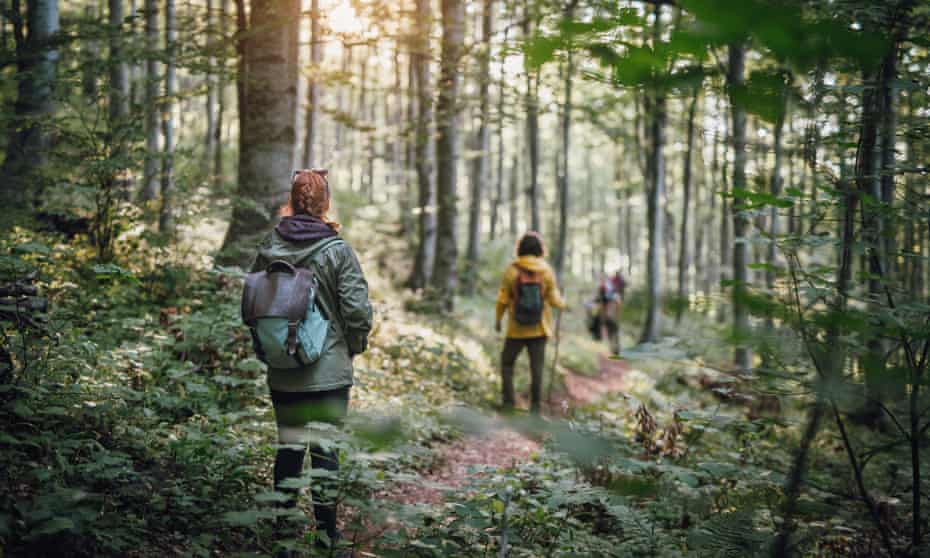The decision to walk contained just that
soupçon of defiance necessary to convince me that while mass hysteria
gripped the nation, I remained calmly autonomous. The physical activity
during those chilly small hours was sufficient to maintain muscle tone
and healthy posture, even if pounding pavement and parkland is no
substitute for pumping iron.
But it’s in the
overall promotion of that quality we’ve come to think of as “wellness” –
in contrast to the apparent sickness of the very planet itself – that
walking seems to come, ambling, into its own.
The Outside Advantage
I
cycle to get around and have increased this since the pandemic, for
obvious reasons. I do yoga from time to time, when my ageing frame
begins to creak and groan. But I confess: going to the yoga studio is a
stretch for me, while gyms have always filled me with an instinctive
revulsion. You don’t have to be a communist to appreciate the force of
Marx’s observation: “The worker does not make use of the working
conditions. The working conditions make use of the worker; but it takes
machinery to give this reversal a technically concrete form.” Well, we
may not work on assembly lines in factories as much as formerly, but I
can’t help seeing the contemporary gymnasium, with its emphasis on
training with machines, as a strange sort of nostalgia for that state:
working out in lieu of… working.
The great virtue of walking is that it requires nothing by way of equipment. There is no joining fee
There’s this problem with the gym – then there’s
that hell described by Jean-Paul Sartre as “other people”. I once
visited Gold’s Gym at Venice Beach in California, the legendary location
for the film Pumping Iron (1977),
which pulled competitive bodybuilding, preening and posing, into public
perception. The gym’s manager told me that the most important pieces of
equipment in the entire establishment were the mirrors, and laughed
indulgently (he was built like the proverbial well-constructed outdoor
lavatory) at his clientele’s, and his own, consummate narcissism. But
for those of us who neither possess such a hardened body nor are
desirous of building one, gyms can be intimidating places –
intimidating, and expensive, too.
During lockdown,
people were doing sit-ups, press-ups and even lifting weights in parks
and other open spaces, but as soon as the gyms reopened, many
disappeared back indoors. I really cannot understand this. To me, the
most bizarre sight in the world is someone on a running or cycling
machine, rather than running, cycling, or, of course, walking. Most of
us, I’d contend, spend too much time either looking at screens (both for
work and leisure) or through them, as we commute to work, drive to the
shop, or even drive to take exercise. The last of these seems to me
another cosmic solecism – and as it’s often the prelude to exercising
inside, constitutes a doubling down on the denatured and technologically
mediated nature of our contemporary existence. And, with the pandemic
unabated, life for many of us has become still more desk-bound, the
outside worlds of work, sociality and leisure all collapsing into two
dimensions and 26-odd inches.
This content is imported from {embed-name}. You may be able to find
the same content in another format, or you may be able to find more
information, at their web site.
The great virtue of walking as a serious pursuit is
that it requires nothing by way of equipment or specialist kit except
the comfortable and hard-wearing shoes you already possess. There are no
joining fees to walk, and you certainly won’t feel body-shamed by your
fellow pedestrians, many of whom will be pensioners on their way to the
shops. Walking is also by its nature spontaneous: you do it all the
time, anyway, so why not simply increase the amount you do? The
pensioners are strolling to the shops. So can you. And you can do it
even if the shops are a lot further off. Which brings me to my main
selling point for new-entrant walkers: its immediacy is what makes
walking so appealing. There’s no need to locate a venue; you simply get
up and walk out whichever door is nearest. I’m fairly rigorous about
this aspect of walking, and I think it’s key to the success of the
entire enterprise. Indeed, while I can just about accept driving to take
a walk in a particularly beautiful or interesting place, for me, the
really life-sustaining walks are the ones I take from wherever I happen
to be.
If I’m in the country, I walk in that countryside.
If I’m in the city, I walk in that built environment. And if I’m in
Selly Oak on a wet Sunday afternoon in January, then I take a walk in
Selly Oak. Walking is the way I bring my mind and body together through
being actively in the place I am, rather than trying to avoid it by
travelling somewhere else, or blot it out by filling one or other of my
senses with quite other environments.
The most
conspicuous example of this is music, via headphones or car stereo, so
as to make a soundtrack for the film of your life – which is really,
when you think about it, creating a giant, imaginary screen around your
experience of the world. I know, you’re thinking, “But Selly Oak (or
Southampton, or Selhurst, for that matter) is pretty boring on a wet
Sunday afternoon in January.” To which I can only reply with one of
those exquisitely annoying parental formulations: if you’re bored, it’s
because you’re boring. And by “boring”, I mean unwilling to take an
interest in anything that doesn’t immediately appeal to you.
This content is imported from YouTube. You may be able to find the
same content in another format, or you may be able to find more
information, at their web site.
Lost Connections
Let me
reinforce this with an anecdote. I once went to Easter Island, the most
remote inhabited island in the world and one of the most exotic and
extraordinary places to boot. The friend I went with was not a walker –
though he did have other virtues – but gamely agreed, in principle, to
join me for some hikes. The first attempt I made to hold him to his
promise was also the last. We had driven to the north end of the island,
where there’s an extinct volcano, Poike. It’s an extraordinary sight:
an eminence of some 370m, entirely covered in grass, but with two
quartz-glinting granitic outcrops on its shoulder, like epaulettes on a
military officer’s tunic. We parked our hire car and began walking
towards it – the giant, bright-green knoll, outlined by the deep
ultramarine of the mid-Pacific Ocean. After no longer than five minutes,
my companion – a famous artist – groaned: “I’m bored.” And I struggled
hard not to pick up one of the chunks of quartz lying in the grass and
use it to bash his brains in.
Which is all by way of illustrating this point: you
cannot come to walking expecting some sort of quick fix. This is the
ultimate slow activity. Yet once you’ve attuned yourself to the
leisurely progress you’re making, you start to appreciate the
extraordinary benefits. For one, as you’re not on an A-to-B journey with
a specific aim in mind, you really can forget about any reward
associated with arrival – such as the endorphin hit beloved of our
running brethren – and instead abandon yourself to the pleasures of
transit itself. In a car, or even on a bike, the world’s contours are
ironed out for you, but on foot there’s a direct correlation between
your muscle movements and your senses. The play of the breeze, the
sunshine (and, naturally, the rain) on your face and any exposed flesh;
the swish of grasses and other herbage against your legs; the smells and
the sights – the walker is constantly surveying the territory he moves
through with a full 360° panoramic viewing.
Moreover,
unlike anyone using mechanised transport, he also has – returned to
him, as it were – the foreground, which for most, most of the time, is
reduced to a blur. The walker, if he consents not to be bored, has
returned to him those vestigial senses of exteroception (the
dispensation of objects in the vicinity), proprioception (awareness of
the dispensation of his own body), and even interoception – that
hearkening to the movements of our internal organs that, for the most
part, we repress.
My walking isn’t simply a leisure pursuit – it’s transportation, entertainment, fitness and therapy
Furthermore, the car
driver, the train and plane passenger – they all see the world around
them as a series of detached views, but the walker is resolutely rooted
in that world, his calves aching as he ascends a hill, his knees taking
up the strain as he descends. I bumper stickerishly proclaimed above
that it’s the journey that matters for the walker, and that arriving
brings no special reward, but there’s at least one exception to this.
When doing really long country walks – and I’m talking around 25 miles
in a day – I find that just before I fall asleep that night, I’m visited
with the most extraordinary reverie. I experience the entire day’s
journey over again: every stile I’ve climbed and stream I’ve leaped, the
whorled windows of cottages I’ve peered into and the muddy furrows I’ve
ploughed along.
The first time this happened
to me, I was overwhelmed. I had just done 25 miles out from central
London and into the Essex countryside. There was the long distance,
which, even as I was walking had gifted me a sensual and immediate
awareness of the topography, and there was the map-reading, whereby I
found myself regularly looking from the three-dimensional territory to
its two-dimensional representation, and then back again.
The way we currently navigate using GPS
systems places us at the centre of the screen and world. In this way, it
gives us absolute location (we can even get a precise grid reference),
yet no real orientation. We’ve all had the experience of getting off a
train or bus and then wandering about trying to coordinate our movements
with those of our little-blue-dot alter ego, so that we can work out
where the hell we are. But old-fashioned map-reading, which is the
method I’d strongly enjoin for longer exurban walks, entails orienting
yourself as a condition of any route-finding at all. This means that the
further you go, the more you start to apprehend that that wood must
border that reservoir – and furthermore, that the ground rising behind
the reservoir must be a spur of that range of hill. It’s this precise
interpretation of the landscape (not without reason is it termed
“map-reading”) that leads to the astonishing exactness of recall. I
retraced that walk into Essex a decade later and found that I could do
it without any recourse to the map, such was the detail with which I
remembered the first venture.
In Search of Lost Time
Of
course, walking without a map is an even more liberating experience. I
am not a rambler, or any other species of Gore-Tex-sporting hiker. Don’t
get me wrong – I have nothing against them, but their preoccupation
with walking in particular places and at particular times is an anathema
to me. My walking isn’t simply a leisure pursuit; rather, it’s
transportation, entertainment, fitness regime and psychotherapy rolled
into one. Apart from the aforementioned sensible shoes, I do take waterproofs
with me. The über-annoying and self-satisfied hikers say things like:
“There’s no such thing as bad weather, only inappropriate clothing.” And
in respect of these temperate and rain-washed isles, they’re most
definitely right. However, though adequately equipped to this extent, I
often set out with no clear idea of where I’m going to go. This is the dérive – or aimless drift – beloved of psychogeographers, among whose number I’m happy to include myself.
Taking
our cue from the Situationists, a group of art revolutionaries who
wandered the storied streets of 1950s and 1960s Paris, we see walking as
a way of not only traversing space but time as well. Let me explain:
once attuned to topography and well versed in the built environment, the
walker becomes alert to a different sort of temporality: not the
collective hallucination of incremental time displayed on the watches
and computer displays that we all look at too much, but the subjective
apprehension of our own duration in this world – our fundamental pace,
if you like. The French Enlightenment philosopher Jean-Jacques Rousseau
(himself no mean stomper) maintained: “We think at walking pace.” And
what’s revealed to me when I’m walking and thinking at the same pace is
the pace of everything around me – just as when we pass by two tall
trees or buildings, their position relative to one another (the parallax
view) makes us aware of the angle of our own traverse, so there’s a
temporal parallax that enables us to become aware of time not simply as
an inexorable river flowing in one direction, but a huge and fluid body
of fluxes and refluxes, in which we swim even as we walk.
I realise the above may seem a little verging on
the mystical – especially if you began reading this with competitive
track walking in mind, so hoping for some straightforward tips on
whether you need spiked shoes, and how to avoid wiggling your arse too
egregiously. I am, however, in deadly earnest. I sincerely believe that a
walker can experience a form of time travel; moreover, that if he
understands the environment he’s moving through even a modicum, there’s a
sort of letting go that occurs as the metronomic beat of the legs
begins to resemble some sort of chant – a physical “om mani padme hum”,
if you like. We’re familiar with the free association of ideas, but in
these states of walking meditation, I often feel as if I am
free-associating places and spaces: seeing where I’ve been in terms of
where I am now, and vice versa, such that it no longer matters if I’m
boxed in by wet privet in Selly Oak on a wet Sunday afternoon in
January.
I would never claim that my sort of
walking is adventurous in the way that man-hauling to the South Pole, or
rowing the Atlantic is considered to be. But I wouldn’t want that sort
of adventure anyway, given that it involves ceaseless and strenuous
repetition to the exclusion of all else. Talk about being bored.
Instead, for me, the adventure begins every day I set out. I’m
confident, even if I’m only walking to a bypass-bound retail park, that
I’ll encounter something fresh, new and provocative – rather than just
another “new car smell” Magic Tree air-freshener, dangling from the
rear-view mirror, like a man caught in a trap.




















